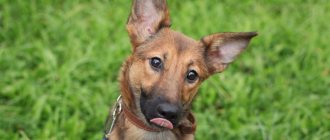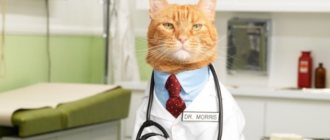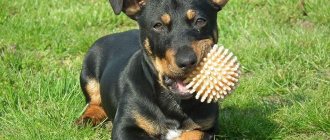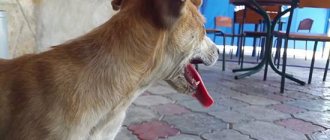A pet can choke for a variety of reasons. Let's look at what to do when a dog coughs as if he's choking and is trying to regurgitate something. By coughing, the dog tries to clear the airways. Sometimes it appears for no apparent reason, which indicates health problems. It is important to distinguish an alarming symptom from a natural reaction.
You should conduct an examination with a doctor in order to identify the pathology in time. Often this indicates colds, because the immune system does not always cope with pathologies. They occur due to hypothermia while walking or after swimming. Often the cause is infection with helminths and hereditary diseases. Your pet may experience discomfort if the collar is not worn correctly.
Causes of cough in dogs
If your pet coughs and tries to vomit apart from eating, this often indicates illness. Typically the causes are the following pathologies:
- Colds. Dogs have a stronger immune system compared to humans, but they also sometimes face the problem. This happens due to swimming in cool water and long winter walks. The disease can develop due to viruses or bacteria. Symptoms such as sore throat, cough, and sore throat are observed.
- Adenovirus. The first sign of pathology is cough. There is also fever, nasal discharge, vomiting, lethargy, loss of appetite, and difficulty breathing.
- Allergic reactions. They can be seasonal, caused by certain foods, pills or chemicals on the skin. They often occur after eating low-quality food or making adjustments to the regular menu. Symptoms such as rashes, itching, sneezing, coughing, problems with the eyes (they become watery and sour) are observed.
- Infection with helminths. Sometimes a pet constantly coughs due to parasites, because they live not only in the intestines. The larvae spread throughout the body through the bloodstream. They occur in different organs, even in the lungs. Then a cough appears, symptoms of pneumonia and bronchitis. With severe infection, worms penetrate the esophagus, which leads to attacks of suffocation.
- Heart problems. A choking cough sometimes indicates heart failure. It is also a sign of enlarged heart muscle pressing on the trachea. A signal goes to the brain that it is under pressure, as if a foreign object has penetrated. Then a natural reaction of the body appears, trying to get rid of the foreign body - coughing.
In addition to diseases, symptoms may appear for the following reasons:
- Inconvenient collar. If your pet starts coughing a lot only outside, this may indicate that the product is tight and the dog is uncomfortable. Normally, two fingers should fit between the fur and the collar. Sometimes owners pull their pet too hard, which causes signs of suffocation. It is important to teach your child the rules of behavior when walking. For an adult, it is worth using a parfors, a tension collar, and a snatch chain.
- The animal choked. Dogs are not picky eaters. They can eat not only a bone, but also a completely inedible object. If your pet is coughing a lot or trying to regurgitate something, then you should offer him a crust of bread. If there is no result, it is better to consult a doctor.
Symptoms of illness
Any disease has characteristic features, according to which the veterinarian makes an accurate diagnosis. Dangerous to the health of the animal is a severe, constant cough, which is combined with the secretion of foam, saliva and is expectorant in nature. The pet sticks out its tongue and makes movements as if expelling a foreign object from its throat.
Most often, such a cough is a signal of some kind of illness or injury. The accompanying signs confirming the pathology include the following options:
- The pet burps, and at the same time a copious discharge of mucus from the nose or foam from the mouth begins.
- The animal begins to rapidly lose weight. There is practically no appetite.
- Activity decreases to almost zero. The pet is depressed, tries to hide, does not want to go for a walk.
- The dog breathes unevenly even with slight physical exertion.
- The four-legged wheezes heavily and sneezes frequently.
- The gums bleed and sores appear on them.
- The temperature rises, chills and trembling appear.
If these symptoms occur, you should be seriously concerned: most likely, the dog is getting sick. He needs to be taken to a veterinary hospital and tested.
What should you do if your dog coughs as if he is choking?
If, regardless of food intake, the dog coughs, chokes and wheezes, as if choking, makes unusual sounds, grunts through its nose, you should look into the cause. The owner will not be able to identify it on his own. You should not try to diagnose it yourself; you should take your pet to the veterinarian.
It is easier for a specialist to determine the disease if the owner participates in the preparation of an anamnesis. The doctor will ask questions about nutrition, walking areas, and changes in behavior. After providing first aid (usually relief of symptoms and taking sedatives), an examination is necessary - a blood test, chest X-ray, ultrasound examination of the heart.
Sometimes serious diseases are detected, even lung cancer. There is a cough, decreased activity, weakness, and shortness of breath. This is usually type 1 adenocarcinoma. Occurs in older individuals. Then steroids are prescribed to eliminate the inflammatory process, bronchodilators to ease breathing. The prognosis is often unfavorable.
Tracheal collapse is diagnosed in miniature breeds. Due to developmental defects, the soft tissues of the trachea become inflamed and softened. Without timely assistance, there is a risk of death from suffocation.
Drugs are prescribed to help get rid of the disease if it is not advanced. Tracheal tissue can be restored by taking nutritional supplements. If there is no result, surgical intervention is required. Instead of damaged tracheal rings, artificial ones are placed.
Cold
If you suspect a cold, you should exclude an important factor. Its symptoms may coincide with many viral diseases. It should be remembered whether there was hypothermia in the last four days. Their absence indicates an acute respiratory infection of a bacterial or viral nature.
The therapeutic method is based on the cause of the cold. In acute cases, treatment with antibiotics is required. But with a virus it will not work. The animal is also prescribed medications to eliminate irritation from the mucous membranes and expectoration.
The pet is being treated at home. In order for him to recover faster, he needs to be in peace and comfort. It is important to provide him with warm, easily digestible and high-calorie food; water should also be heated. When taking antibiotics, you will need to pay attention to restoring the intestinal microflora.
Viruses are eliminated with special drugs. If you suspect them, you should not start self-medication. Pathology may occur in the following cases:
- Lack of vaccinations.
- Contact with infected animals with an acute form of the disease.
- Walking through natural landfills.
- Interaction with wild animals (hedgehogs, squirrels).
- Weakened immune system, previous serious illness.
- Recent surgery, long recovery and antibiotic use.
- Sleep problems.
- Age up to one year or after eight years.
Kennel cough
It is also called aviary cough, viral tracheobronchitis. Infection often occurs in pet stores, exhibitions, and walks. A few minutes spent in the same room with an infected pet is enough. There is a urge to vomit and a dry cough.
The disease can be mild and not cause harm to health. In severe cases, complications such as pneumonia occur. Therefore, you should contact your veterinarian.
For treatment, expectorants and cough suppressants are prescribed. In severe cases, antibiotics are required. It is important for the owner to place the dog in a warm room, ensure normal humidity and peace. Interaction with other pets is prohibited.
To prevent kennel cough, you should be vaccinated against adenovirus. If the baby was brought from a nursery, he should be quarantined for 14 days. If a cough occurs after vaccination, it is important to take the dog to the clinic.
Airway injuries
If the respiratory tract is damaged, coughing (in some cases with blood), loss of appetite, vomiting, suffocation, and wheezing is observed. Sometimes this occurs due to pressure from a collar or chain. When liquid gets into the lungs, the symptoms are identical.
In-office surgery is often required. It is prohibited to give laxatives.
Parasites
You can become infected in unsanitary conditions and even after a mosquito bite. In the latter case, dirofilariasis develops. These are heartworms that attack internal organs. The pathology is difficult to treat.
There is a cough, lethargy, drowsiness, swelling of the front legs and sternum, loss or increase in appetite. Specific medications are prescribed, sometimes containing arsenic. Self-medication with folk remedies is unacceptable. Heartworm is difficult to get rid of, so it is important to take preventive measures, that is, use insect repellents.
To prevent infection, you need to carry out regular deworming. Preparations for this purpose are purchased at an animal pharmacy.
Allergy
If a symptom appears after a walk, this may indicate an allergic reaction. Sometimes it occurs due to certain foods, drugs, dust, pollen, chemicals. It is easier to identify and eliminate food allergies. This requires a change in diet. It usually manifests itself in proteins. Then one of its sources is replaced by another. For example, instead of beef they give duck. In severe cases, you will have to buy hypoallergenic food.
If the reason is different, then use the exclusion method. Seasonal cough occurs due to blooms and dust. In case of an allergic reaction, severe discharge from the nose and eyes and swelling of the mucous membranes are observed.
Heart problems
In heart failure, shortness of breath, loss of appetite, weakness, and blue discoloration of mucous membranes are observed. The cough is severe in the morning and at night, the pet has difficulty withstanding hot weather and humidity.
The mitral valve of the heart is affected. The organ enlarges and fluid accumulates in the lungs. Large dogs often suffer from cardiomyopathy (DCM). The pathology is characterized by rapid development and the presence of concomitant arrhythmia.
For heart diseases, self-medication is unacceptable. The specialist will prescribe the necessary tests, procedures and medications. The prognosis depends on the age of the dog and the severity of the pathology.
A cardiac cough is considered the earliest sign of heart failure. It is often diagnosed in older individuals.
Diagnostics
There is considerable controversy regarding the appropriate way to diagnose LPR.
Most patients are diagnosed clinically, based on symptoms associated with LPR.
During laryngoscopy (examination of the larynx), swelling and hyperemia (redness) of varying degrees are noted. However, the relatively weak correlation between symptoms and endoscopic findings argues against the use of endoscopic diagnostic methods.
The Reflux Symptom Score and Reflux Symptom Index are well suited for both diagnosis and monitoring response to therapy.
Daily Ph-metry with a dual sensor probe, despite its excellent sensitivity and specificity, is questioned, since the results of this diagnostic method often do not correlate with the severity of symptoms.
Another diagnostic option may be empirical PPI therapy.
What to do if your dog can't clear his throat?
If your pet coughs a little and there are no other signs of pathology or changes in behavior, you should not worry. It's worth watching him for a day. If additional signs appear, such as fever, weakness, apathy and shortness of breath, it is worth taking him to the clinic.
The veterinarian will conduct an examination, diagnose the disease and prescribe treatment. Do not ignore a serious situation and go to the pharmacy for medicine without a prescription. Such behavior can be fatal for your pet, because it is impossible to diagnose the disease yourself.
In case of an attack of suffocation, you should act as follows:
- The small dog needs to be turned upside down, shaken (almost like a blanket), and patted on the back.
- When a reverse sneezing attack occurs, your pet needs to swallow saliva or take a deep breath. It is important for the owner to help the dog by pinching its nostrils or stroking its throat.
- A large animal will need to be brought to a standing position, its rear end raised slightly and the sternum firmly patted. If possible, you can carry out manipulations as with a small dog.
- It is necessary to ensure that during an attack the pet does not choke on its own tongue.
- If your pet has a short muzzle, you should place a finger in the mouth and check the opening of the airways. Representatives of the breeds often have a long and soft palate. Because of this, the airways are blocked.
- Stopping breathing requires resuscitation. Closed heart massage and ventilation are performed.
Video: what to do if your dog coughs as if he’s choking and is trying to burp something?
How to find out what is causing a cough
A dog's cough can be due to external causes - cold air, rapid swallowing of food, a tight collar or strong tension on the leash. There is no danger to health; it is enough to eliminate these causes of cough in the dog, and everything will go away.
If a dog coughs frequently, the reasons may be serious - diseases of the throat, respiratory tract and heart, allergies and foreign bodies in the larynx, tumors and parasites. Repeated canine cough is not a disease, but a symptom of an illness that rarely goes away on its own. Before treating a dog’s cough, it is necessary to observe the pet and collect a complete history, which is necessary for the veterinarian to determine the diagnosis.
What to pay attention to so that you can correctly determine why your dog is coughing:
- frequency and regularity of cough;
- how long ago did it appear;
- The dog has a dry or wet cough;
- is there any admixture of blood, mucus or pus in the sputum;
- the pet chokes when coughing or tolerates it calmly;
- what sounds does a dog make when clearing its throat?
- general health, activity, presence or absence of appetite;
- whether there are difficulties with swallowing food or water.
It is necessary to remember whether there was interaction with unfamiliar or unhealthy dogs, whether the pet was on a self-walk, whether there was hypothermia, what food he ate before a severe cough or frequent coughing began.
In addition to taking your medical history, your veterinarian will perform a visual examination. Swelling, enlarged lymph nodes, cyanosis of the mucous membranes, heart rhythm disturbances, diseases of the teeth and gums - all this, together with a cough, proves the presence of a certain disease.
Prevention
Preventing the occurrence of pathology is easier than trying to cure it. Available preventive measures will help strengthen the immune system and ensure the body's resistance to viruses.
Dogs should be taken to the veterinary clinic periodically. It is necessary to carry out timely deworming. Vaccination should also not be neglected - it will help avoid a large number of diseases.
The diet should be balanced, the pet should be given vitamin complexes, especially in spring and autumn. It is important to ensure that living conditions are favorable - maintain a comfortable temperature and humidity level. Long and regular walks along with physical activity have a beneficial effect on the immune system.
Owners should be aware of their responsibility for their own pets. Any changes in appearance and behavior should be alarming. If there are alarming signs, you should seek the help of a veterinarian. Treatment of each pathology is easier if it is identified at the beginning of its development.
Treatment of laryngopharyngeal reflux
Lifestyle changes and diet are the main approach in the treatment of LPR and GERD. The role of drug therapy is more controversial. It is unknown whether asymptomatic patients with incidentally detected signs of LPR require treatment. There are theoretical concerns that LPR may increase the risk of malignancy, but this has not yet been proven. In any case, patients with asymptomatic LPR are advised to follow a diet.
Patients are advised to quit smoking, alcohol, and avoid foods and drinks containing caffeine, chocolate, and mint. Prohibited foods also include most fruits (especially citrus fruits), tomatoes, jams and jellies, barbecue sauces and most salad dressings, and spicy foods. Small meals are recommended.
You should avoid exercise for at least two hours after eating, and refrain from eating or drinking three hours before bedtime.
Drug therapy usually includes proton pump inhibitors (PPIs), H2 blockers, and antacids. A PPI is recommended for six months for most patients with LPR. This figure is based on the results of endoscopic studies (this is the time needed to reduce laryngeal edema), as well as the high percentage of relapse in the case of a three-month course of therapy. Discontinuation of therapy should be carried out gradually.
If therapy with PPIs and H2 blockers is unsuccessful, treatment with tricyclic antidepressants, gabapentin and pregabalin should be considered, since one of the possible mechanisms for the development of reflux is increased sensitivity of the larynx.
Risk group
Cough occurs in all types of animals and dogs are no exception. Breeds that are more or less susceptible to this symptom are not distinguished. But depending on the disease that causes coughing attacks, some features can be distinguished.
For example, small and toy breed dogs are more prone to tracheal collapse and reverse sneezing.
Diseases of the cardiovascular system are observed more often in large breeds and overweight dogs.
And respiratory diseases are associated with hunting and sporting dogs exposed to heavy stress.
Often a cough begins in winter; perhaps the dog just has a cold.











